Philodendron plants from the family Araceae are hugely popular all over the world, with many common species freely available for purchase at most nurseries.
However, there are a few stand-out cultivars that are harder to get hold of but increasingly sought-after for their incredible aesthetics. One of these is the Philodendron Gloriosum.
With its huge, heart-shaped leaves defined by bright white and pink margins and delicate light green veins, the Gloriosum is the darling of the Philodendron family and every true enthusiast’s dream.
Unlike its many cousins, it’s a crawling rather than a climbing plant, but true to philodendron form, it’s super easy to look after.
In this article, I’ll take a deep dive into everything there is to know about the Philodendron Gloriosum, from how much you can expect to pay for one to how large they get and their care requirements. Ready? Let’s jump right in.
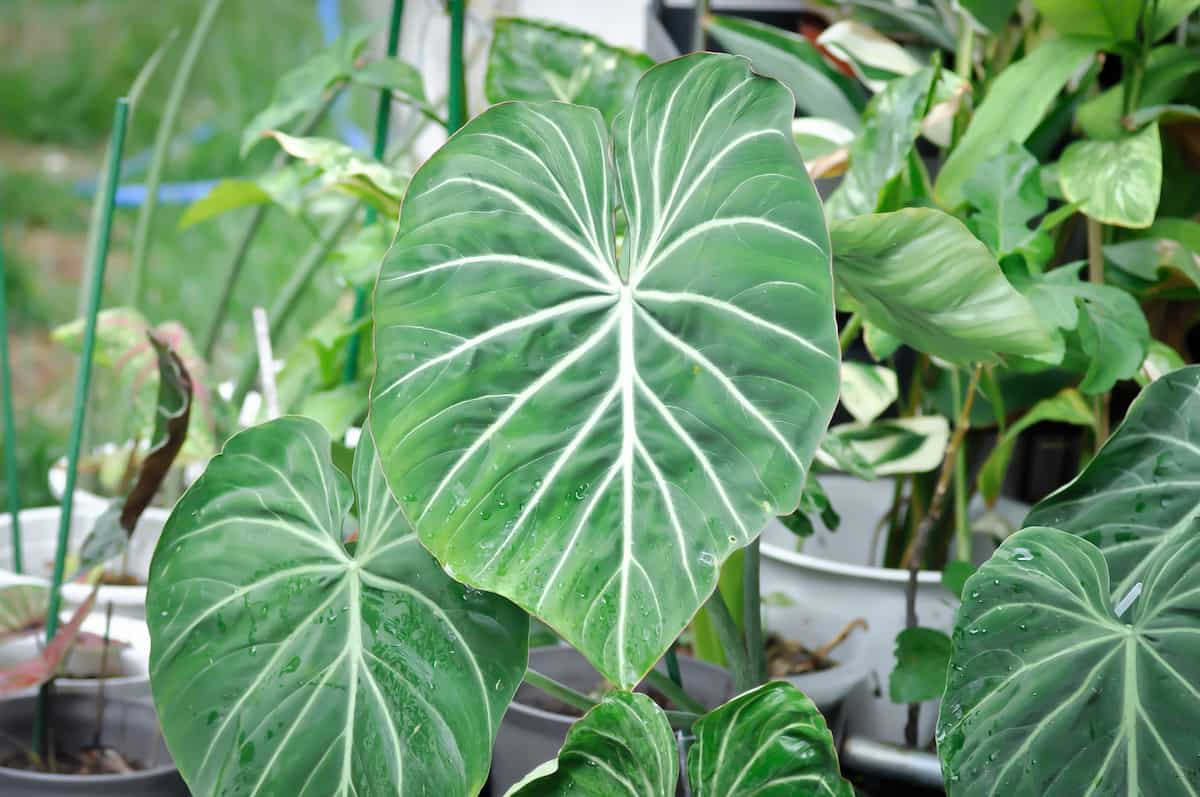
Table of Contents
How to care for a philodendron gloriosum
The best way to care for a Philodendron Gloriosum is to try and emulate its natural, tropical environment as closely as possible. This involves providing it with bright, indirect light, plenty of warmth and humidity, well-draining soil, good hydration, and seasonal feeding. Occasional pruning and cleaning also help your Philodendron Gloriosum’ overall well-being.
Philodendron Gloriosum make great houseplants, and if you have any hesitation about their care, worry no further. These gracious green beauties are low-maintenance and straightforward in terms of their needs, making them perfect for even beginner plant parents.
Bearing in mind that Philodendron Gloriosum are tropical plants, the best environment you can offer them is one where they’ll have a sunny spot with lots of light, relative humidity, and plenty of moisture.
In good news, most homes are already set up for this with East and South-facing windows and a generalized humidity level of around 50%. To supplement the rest of their care needs, you just need to ensure your Philodendron Gloriosum stays hydrated, is fed with both good soil and that you occasionally fertilize your philodendron.
In the following sections, we’ll look at Philodendron Gloriosum care in greater detail to equip you with everything you need to help your houseplants thrive.
How much light does a philodendron gloriosum need?
Philodendron Gloriosum prefer at least six to eight hours of bright, indirect sunlight each day. As their leaves can be vulnerable if they receive too much light, keep an eye out for any signs of sunburn on your Philodendron Gloriosum’s leaves, such as yellowing leaves or brown spots appearing.
Most (if not all) plants depend on sunlight energy to grow, and Philodendron Gloriosum are no different. Native to tropical America, they’re accustomed to dappled light from the jungle canopies above them, which you can try to mimic in the home with clever positioning.
In the winter, when it starts to cool down, and there is less indoor sun available, a Philodendron Gloriosum’s light needs can be augmented with a bit of time spent outdoors on a sheltered patio or balcony. The fresh air will do them good, too.
Find out more: Philodendron Light Needs: The Ultimate Guide
What is the right temperature for philodendron gloriosum?
Your Philodendron Gloriosum will thrive in temperatures between 75°F and 85°F (23°C to 29°C). While they can survive at lower temperatures than this, don’t let them stay for too long anywhere less than 65°F (18°C) as your plant may not survive.
Clearly some plants, like Philodendron Gloriosum, like it hot. However, the real kicker is ensuring your Philodendron Gloriosum are placed in an area with mid-to-high humidity.
What are the best humidity levels for a philodendron gloriosum?
Philodendron Gloriosum prefer humidity levels of around 65% to 80%. Given that they are native to tropical Central and South America, they thrive in humidity conditions similar to their natural habitat. However, most homes won’t reach these levels, so you may need to boost this for your Philodendron Gloriosum to thrive.
Houseplants that receive adequate amounts of sunlight daily generally don’t require supplementary humidity, particularly if you consider most homes fall in the 40% to 50% range. However, with their tropical inclinations, Philodendron Gloriosum can benefit from a little extra care in this regard.
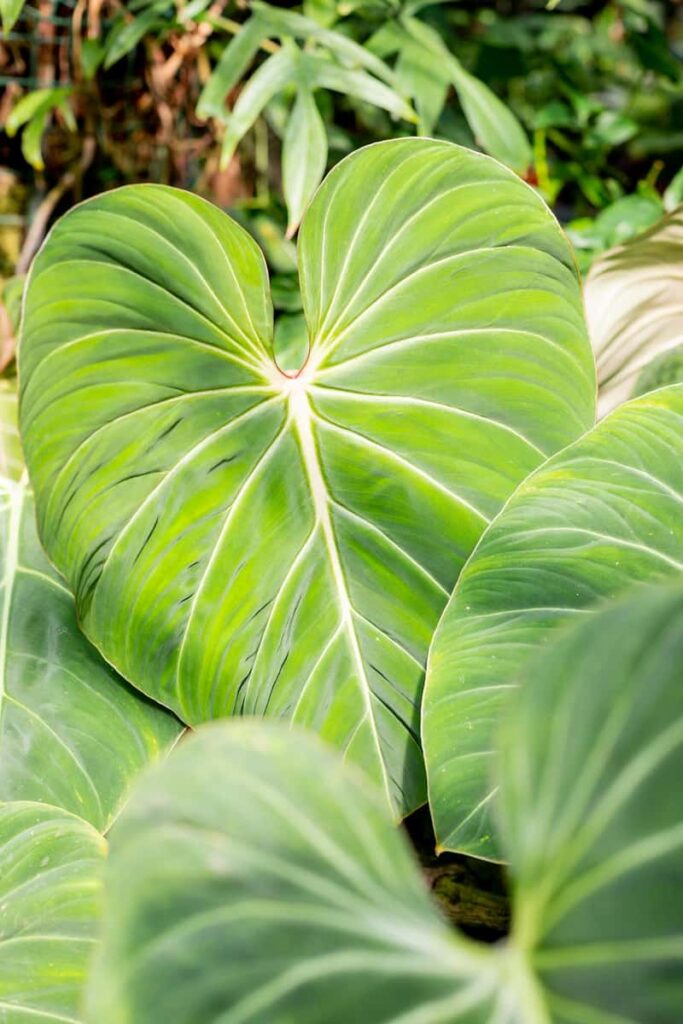
The easiest, in my opinion, is to invest in a small plug-in humidifier. Alternatively, you can rest your Philodendron Gloriosum on a damp pebble tray, making sure not to let their roots touch the water.
Alternatively, if you have a whole collection of houseplants, cluster them together so they can benefit from each other’s transpiration processes. It has the added benefit of looking great too!
What soil is best for philodendron gloriosum?
A Philodendron Gloriosum’s soil mix should be loosely clustered, nutrient-rich, and well-draining. The high nutrient level emulates its natural habitat, where plant material in the rainforest falls onto Philodendron Gloriosum and nourishes them. Having light and airy potting mix helps to avoid the soil staying too soggy, which can lead to root rot.
While many Philodendron Gloriosum varieties have aerial roots as well as ground-dwelling (terrestrial) roots, they receive the bulk of their vitamins and minerals from their soil, making it an essential part of their fundamental care.
Top pick: My preferred soil for Philodendron Gloriosum is the Miracle-Gro Tropical Potting Mix (check the latest price here).
It’s very well draining and will feed nutrients to your Philodendron Gloriosum for up to six months. For a tropical plant like the Philodendron Gloriosum, it’s got everything you need.
Buying pre-blended Philodendron Gloriosum soil from most garden centers is a simple option. Alternatively, you can easily mix your own by combining potting soil with chunky bits of bark (grab some here) and moisture-retentive perlite (get it here).
If you’re buying your Philodendron Gloriosum pre-potted, they’ll likely arrive in appropriate soil from the get-go. Even so, you’ll need to replace their soil every 18 to 24 months to prevent a build-up of salts or eliminate any beasties and creatures like pests, fungi, or bacteria, so make sure you’re replanting them in the best soil for philodendrons so they continue to thrive.
Indeed, this is a good maintenance practice for all houseplants, not just Philodendron Gloriosum!
How often should you water philodendron gloriosum?
You should water your Philodendron Gloriosum when the top two inches of its soil has dried out, which you can test by sticking your finger into your plant’s potting mix. In summer, this will be around once per week, but may be less frequent in the cooler months.
It’s always good to have a watering schedule for your plants, but with so many factors (like season and sunlight) at play, I prefer to meet my Philodendron Gloriosum’s watering needs as required – by waiting for their top inch of soil to dry out before hydrating.
The reason for this is that the leading cause of fatality in Philodendron Gloriosum is root rot, which they tend to contract from overly soggy soil or from standing in pooled water. As they’re pretty drought-tolerant, it’s best to err on the side of caution and only water philodendrons as they need it rather than strictly once-per-week.
That said, when you do water them, a hearty dose of moisture is great, provided it doesn’t make their soil soggy and heavy, which weighs down on their root systems.
When should I fertilize my philodendron gloriosum?
Philodendron Gloriosum likes some fertilizer every now and again. In fact, they do their best when they are fed twice a month during their active growing season, which is the spring and summer. However, you shouldn’t fertilize your Philodendron Gloriosum during its dormant period in the cooler months.
This is because feeding the plant during this time can interfere with its natural growing cycle.
Overall, though, occasional feeding with a balanced fertilizer is greatly beneficial for Philodendron Gloriosum, especially at the start of their growing seasons in the spring and summer months.
If you think about it, these jungle-dwellers are used to all the rich, dense nutrients they have access to from the forest floor, which can’t be substituted by typical potting soil. An all-purpose liquid fertilizer at half strength is a good way to replace their natural feeding schedule, providing them with an extra dose of energy for new growth.
My top pick: My recommendation for the best fertilizer for your Philodendron Gloriosum is EZ-Gro 20-20-20 All Purpose Liquid Fertilizer.
It’s extremely easy to use and has the perfect balance of nutrients for Philodendron Gloriosum. You can check the latest price here.
Should I prune my philodendron gloriosum?
You should prune your Philodendron Gloriosum from time to time as part of their regular maintenance, with spring being the best time of the year to do this. Removing dead foliage or browning stems will allow robust leaves and vines to draw in more sunlight and stop your plant from wasting energy.
Just like humans shower, cut their hair, and clip their nails, Philodendron Gloriosum can do with occasional grooming, especially when it comes to eradicating old or dying growth. Fortunately, trimming your philodendron really isn’t hard to do.
When it comes to cleaning, remember that each large leaf of your Philodendron Gloriosum is full of sunlight receptors that are easily blocked by dust or grime. Wiping down your leaves with a damp cloth keeps them clean and free to function at their best.
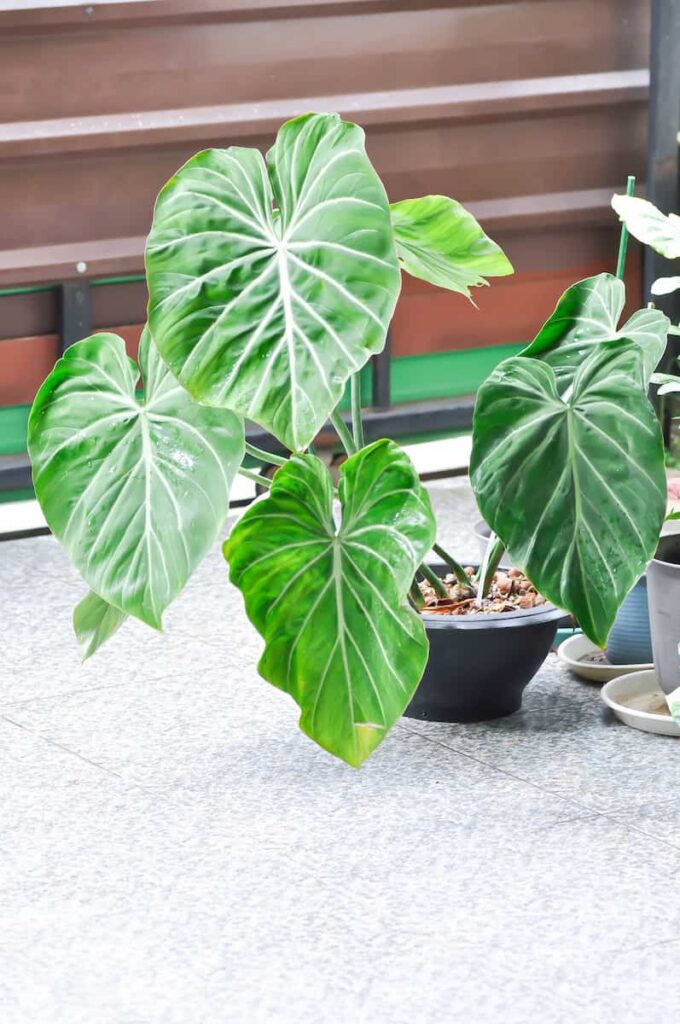
When should I repot my philodendron gloriosum
The Philodendron Gloriosum is not a plant that needs to be repotted regularly, with it often only needing to be transplanted every two to three years. With that said, however, you should repot your Philodendron Gloriosum if you see roots growing out of the drainage holes.
In fact, this plant does well when it is rootbound. That said, when you do transplant a Philodendron Gloriosum, do so in spring before the plant starts to produce new growth, and select a pot that is about 3 sizes larger than the current pot.
Alternatively, you can wait until fall to perform the transplant.
Find out more: 7 Simple Steps to Repot Philodendrons (+ When To Do It)
Should I propagate my philodendron gloriosum?
Yes, it is very straightforward to propagate a Philodendron Gloriosum by taking a cutting with a visible node and rooting it in either water or soil. Water propagation tends to be easier with Philodendron Gloriosum, with roots usually appearing within six to eight weeks. At that point, transplant the cutting to soil.
Overall, though, as if we didn’t already have enough reasons to love Philodendron Gloriosum, one of their best characteristics is how easy they are to propagate. This is excellent news for those who want to multiply their houseplants or can’t bear to see clippings from regular pruning go to waste.
Like their care requirements, Philodendron Gloriosum propagation is straightforward, provided you get your fundamentals right. A significant aspect of this is selecting cuttings prime for new growth or, in simpler terms, stems with nodes that can produce roots.
How to propagate a philodendron gloriosum
The easiest way to propagate your Philodendron Gloriosum is to root it in water. Simply place your cutting into a jar with water in it and place it in a warm sunny spot, and wait. Refresh the water once a week to keep it oxygenated and, in six to eight weeks, new roots will appear.
At that point, your Philodendron Gloriosum cutting will be ready for transplantation!
Philodendron Gloriosum can be propagated from stem cuttings, provided they have a visible node and a leaf or two to draw in moisture from the air. You can either root your cuttings in water first or plant them directly into soil.
Find out more: 10 Easy Steps to Propagate Philodendron Cuttings
Alternatively, if you only have a small piece of stem, you can try to root them in a nutrient-rich growing medium with concentrated humidity.
That is, a second option is to place your cutting directly into a planter with soil. This is slightly riskier as they require a lot of humidity to make up for the moisture they’d usually draw via roots, but it can be equally effective with proper care.
If your cutting has no leaves, try laying it on a bed of peat moss and covering the tray or container with plastic to retain humidity. While this method isn’t always effective, it’s worth a try to avoid throwing away any pieces of your precious plants.
What’s a standard philodendron gloriosum price?
Due to high demand and scarcity, the Philodendron Gloriosum is on the steeper end of the scale when it comes to its purchasing price. A juvenile plant or cutting will set you back around $100, with mature plants often going for $250 or more.
Like a great work of art, the Gloriosum, unfortunately, comes at quite a price and isn’t all that easy to find. Of course, this is changing slowly as they see a drastic increase in popularity. But, for the time being, some of the reasons contributing to their scarcity are high demand and slow development.
To elaborate, the Gloriosum is native to South and Central American rainforests and, more specifically, Columbia. It is not naturally occurring in the countries where it is most commonly purchased as a houseplant, meaning it needs to be grown in specialist conservatories and greenhouses.
Adding to this, the Gloriosum is slow-growing and even slower to propagate, making it difficult for the suppliers mentioned above to keep up with the pace of demand.
Why is the philodendron gloriosum so expensive?
When it comes to producing new Philodendron Gloriosum plants, suppliers and enthusiasts need to practice quite a bit of patience, which lends to their hefty price tags. The main reason for this is that Gloriosum are rare, so finding a cutting for propagation isn’t easy or cheap.
Seeds, too, are nearly impossible to obtain, as it can take up to 15 years for a Gloriosum to flower (and don’t get too excited there for your own plant, as it’s almost unheard of for an indoor philodendron to flower).
Indeed (and strangely enough), the fact that the Gloriosum is so sought-after is another factor that adds to its price. Collectors of rare plants don’t mind paying a little more to add to their collections, making it easier for cultivators to market them to higher bidders.
Is philodendron gloriosum hard to care for?
Philodendron Gloriosum are hardy and robust, with straightforward care requirements. They prefer humid environments with medium indirect light, regular hydration, and mineral-rich soil. They aren’t particularly prone to diseases other than root rot and don’t require much in terms of fertilization or pruning.
If you’re fortunate enough to have gotten your hands on a Gloriosum, the good news is that they’re effortless to look after. And once your plant has settled, you should have no problem helping it thrive. Getting your fundamentals right is key, with humidity being the main priority to help your Gloriosum feel at home.
Before we get into that, let’s look at water, soil, and light. Being tropical, a Philodendron Gloriosum likes regular hydration (at least weekly), but not so much that it develops wet feet. I strongly advise allowing at least the top inch of soil to dry out between watering to reduce the risk of root rot.
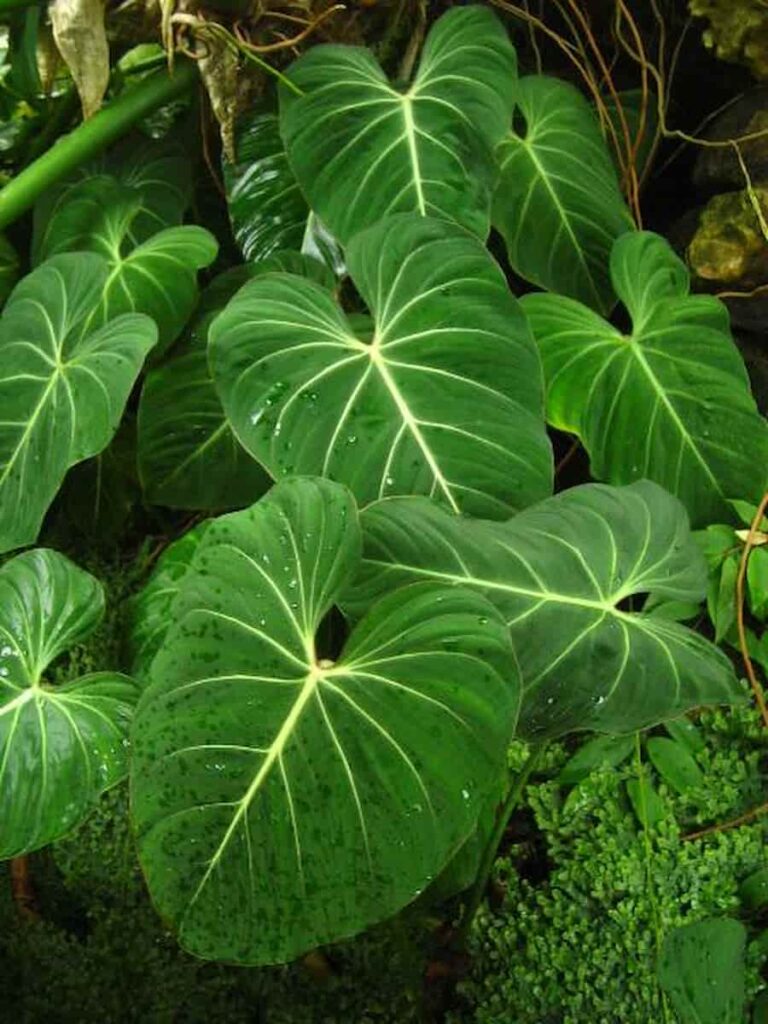
Regarding a Gloriosum’s light needs, your best positioning is close to a window but not in direct light. Lower light areas are sufficient, with medium access for 6 to 8 hours per day being more than adequate. Direct sun can scorch a Gloriosum’s beautiful leaves, so it’s best to avoid this if possible.
In terms of soil, philodendrons, in general, love nutrient-rich soil with plenty of good circulation and high drainage levels. A non-clumping medium like orchid barks takes some of the pressure off your Gloriosum’s root system, while perlite helps to retain moisture for longer.
How much light do variegated philodendron gloriosum need?
Variegated Philodendron Gloriosum have slightly different light requirements to normal, pure green Philodendron Gloriosum due to a lack of chlorophyll in the lighter parts of their leaves. It is paramount that they receive at least eight hours of indirect light daily (and up to ten), which will keep them energetic for new growth.
In the plant world, variegation refers to leaves with more than one color, either a lighter green or gray shade or a bright cream or white.
A leaf’s green coloring is a consequence of chlorophyll cells, so it follows that the lighter the color, the less chlorophyll is present. Biologically, it is these cells that plants use to convert sunlight into energy via the process of photosynthesis.
Therefore, variegated Philodendron Gloriosum have fewer cells for energy production, which is why they require just a bit more light than average. In general, being close to sunny windows with all-day light will suffice, but if you can’t provide this, you can supplement their needs with grow lights.
Another option is to place your variegated Philodendron Gloriosum outdoors in a shaded spot for a few hours a day, especially in the winter sun, to compensate for any deficits. Just make sure to keep them away from direct light (so they don’t contract sunburn), as well as from wind and rain.
Are philodendron gloriosum toxic?
Philodendron Gloriosum are toxic to humans and animals, as they contain sharp calcium oxalate crystals that cause skin irritation through direct contact, or gastrointestinal distress and other potentially dangerous symptoms when ingested. All parts of the plant contain these crystals, which are most prevalent in its sap.
While Philodendron Gloriosum are indisputably beautiful in the home, it is best to keep them away from curious kids and pets, as skin contact and ingestion can be highly irritating at best and have real health consequences at worst.
These plants’ sticky white sap is full of needle-like calcium crystals. When they make contact with bare skin, they can cause welts or irritating rashes, which, fortunately, can usually be treated with a topical skin ointment.
Be aware: Ingestion of any part of a Philodendron Gloriosum can cause swelling of the throat tissue, nausea, dizziness, diarrhea, and other symptoms of gastrointestinal distress. In a worst-case scenario, ingestion can cause difficulty breathing, in which case, medical treatment should be sought as a matter of urgency.
While this all sounds very daunting, the good news is that these plants don’t taste good, so there is no real reason (other than curiosity or carelessness) why rogue children or pets would eat them. Even so, prevention is better than cure, so place your plants out of reach if you’re concerned they may get chomped.
Why are my philodendron gloriosum’s leaves turning yellow?
There are a few reasons why Philodendron Gloriosum leaves turn yellow, but the primary cause is overwatering, with yellowing leaves being an early sign of root rot. Damaged roots cannot transport nutrients, oxygen, and water to a plant’s leaves, which causes cell death, and by default, turns them yellow.
I find watering my plants to be the most cathartic exercise on earth. However, with some trial and error, I’ve learned that my Philodendron Gloriosum, in particular, doesn’t do well with being over-loved.

While they’re super hardy, too much hydration can quickly cause root rot in philodendrons – a fungal or bacterial infection that destroys your plant’s root system.
Therefore, if you notice yellowing leaves on your philodendron, run a diagnostic immediately. Is your soil damp or soggy? Allow it to dry out, which may reverse some of the damage. Lots of sun helps. Or if the damage is progressed, try repotting your Philodendron Gloriosum, removing damaging roots in the process.
A secondary cause of yellowing leaves is chemical burn, which your Philodendron Gloriosum may contract from over-fertilization. In this case, transplantation is also recommended, followed by a restriction of your feeding practices.
Why is my philodendron gloriosum drooping?
Drooping and wilting in Philodendron Gloriosum is more often than not related to watering practices. Too little water can cause fatigue which will make your plant look droopy, while too much water (or root rot) can also cause ill health. Generally, when a plant wilts, it is trying to communicate that it’s unwell.
While a drooping Philodendron Gloriosum is distressing, it’s not usually terribly serious and most likely due to dehydration. This can be solved with a dose of water and sunlight and, of course, more consistent care going forward. In no time, your plant should be back to its old self.
Conversely, if this doesn’t do the trick, your philodendron leaves curling may indicate an underlying issue like root rot, which, ironically, is caused by overwatering. If you suspect this is the case, you may be best off transplanting your Philodendron Gloriosum into fresh soil and readjusting your watering schedule.
A third cause of drooping is related to light. If a Philodendron Gloriosum isn’t receiving enough sun, it will tell you by dropping its leaves and wilting. Remember, six to eight hours a day is critical, and if you can’t provide this, mitigate potential drooping with supplementary grow lights.
Related: 10 Causes Of Your Philodendron Not Growing (+ How to Fix It)
Why are there brown spots on my philodendron gloriosum?
Like yellowing and drooping, brown spots on a Philodendron Gloriosum are a sign of a health ailment. Browning, in particular, is mainly caused by pest infestations or bacterial and fungal infections. The best way to get rid of brown spots is to identify the cause and then treat your plant accordingly.
None of us want to see our Philodendron Gloriosum suffer, and brown spots usually aren’t a very good sign. If you notice your philodendron leaves turning brown, the first thing you want to do is identify the cause, whether it be pests or soil-related.
In the case of creepy crawlies, you can treat your Philodendron Gloriosum by washing it down with a horticultural soap, followed by a wipe with neem oil. Remove damaged growth, and give your plant lots of love, water, and light.
On the other hand, bacterial and fungal infections are best treated by getting rid of old soil. I highly recommend transplanting your Philodendron Gloriosum (preferably in spring or summer), and cutting away any visible root and leaf damage, provided it’s not more than 30% of your plant’s total volume.
Brown spots on philodendron can also be caused by sunburn, but in this case, they’ll look more like a sheen than a spot, per se. Sunburn can be prevented by keeping your Philodendron Gloriosum out of direct light.
Where to find a philodendron gloriosum for sale
As a commonly known and well-loved houseplant, Philodendron Gloriosum are easy to find and can be purchased from most nurseries or garden centers. To buy them online, Etsy is always a good option. Rarer varieties can be bought from online merchants or specialized breeders or traded among collectors.
In the mood for a Philodendron Gloriosum? You’re in luck. These beauties are freely available on the market and are considered one of the most popular houseplants around.
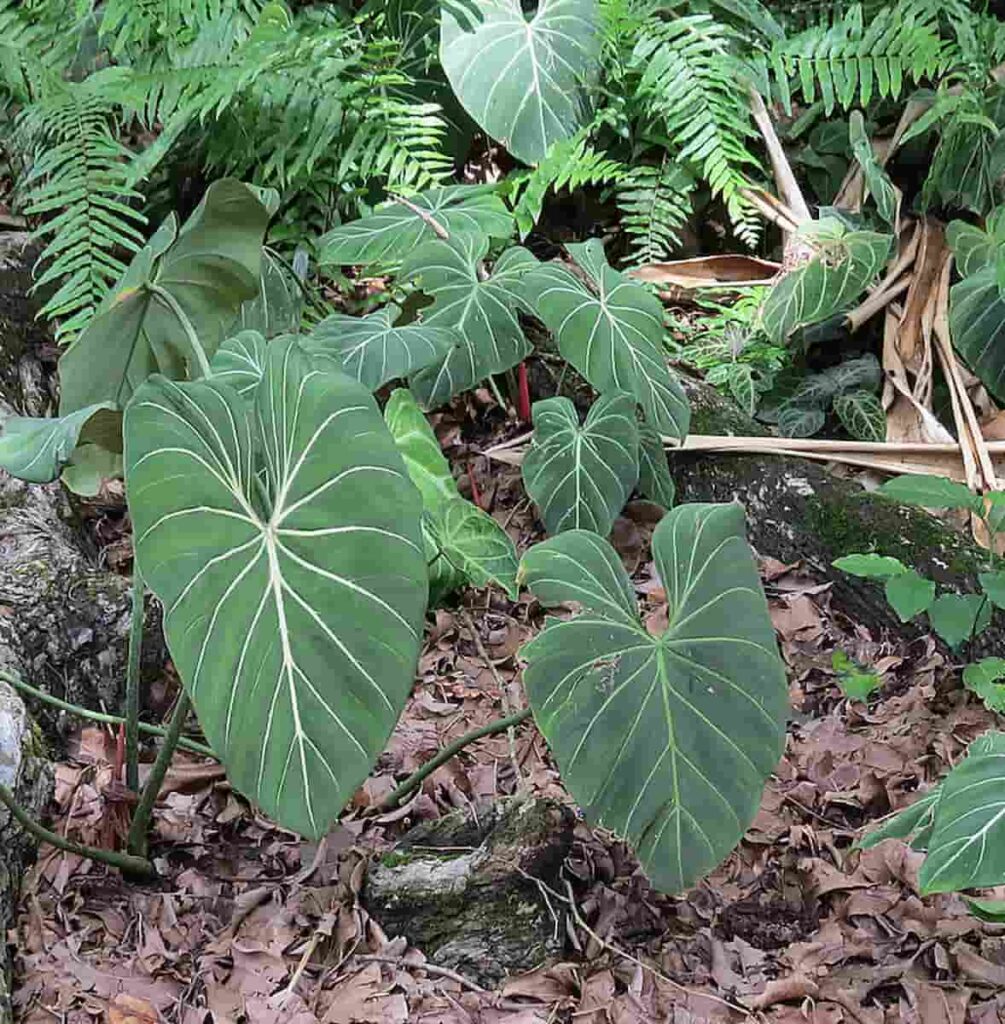
Of course, if you’re after rare collector’s items, you may need to double down on your search and rely on specialists. But if you’re simply looking for some of these beauties to adorn your home (which is definitely a good idea!), you can pop out and get one from your local nursery today.
How do you make a philodendron gloriosum bushy?
The best way to make a Philodendron Gloriosum bushy is to prune it in its growing season, which is spring and summer. Make sure you remove any dead or dying leaves, as this ensures your plant doesn’t spend energy on this foliage and will instead focus on new growth.
Funnily enough, regularly trimming your plant is actually key to maximizing your philodendron’s growth rate.
Regularly turning your plant so that all its angles receive sunlight is another good way to ensure consistent, rounded, and aesthetic growth with a clustered appearance to make your philodendron fuller.
You can also use a moss pole so that your Philodendron Gloriosum has space to climb upwards, which is what it would do in its natural environment – aiming upwards towards a source of light.
Does philodendron gloriosum need high humidity?
Bearing in mind that the Philodendron Gloriosum is a tropical plant, access to humidity is vital to its care. It thrives in a moisture-rich environment that emulates its rainforest home. And while this isn’t always possible indoors, you can supplement humidity in several ways.
To start, consider investing in a plug-in humidifier. Alternatively, if you’d prefer a more organic root, you can set your Gloriosum over a damp pebble tray, provided its roots don’t touch the water.
Another ingenious trick I’ve recently learned is to cluster your houseplants together, where they can mutually benefit from one another’s natural gas exchanges.
Can you grow philodendron gloriosum in LECA?
LECA, better known as Lightweight Expanded Clay Aggregate, is an excellent substrate in which to grow your Philodendron Gloriosum, particularly if you’re a little on the forgetful side. This is because it ticks many boxes related to a Gloriosum’s care, including moisture retention, air circulation, and acid neutrality.
But unlike soil, it doesn’t require much maintenance, as the small clay balls release hydration gradually, only needing a top-up every few weeks when they dry out.
LECA is also an excellent growing medium for plants with a shallower root system like the Gloriosum.
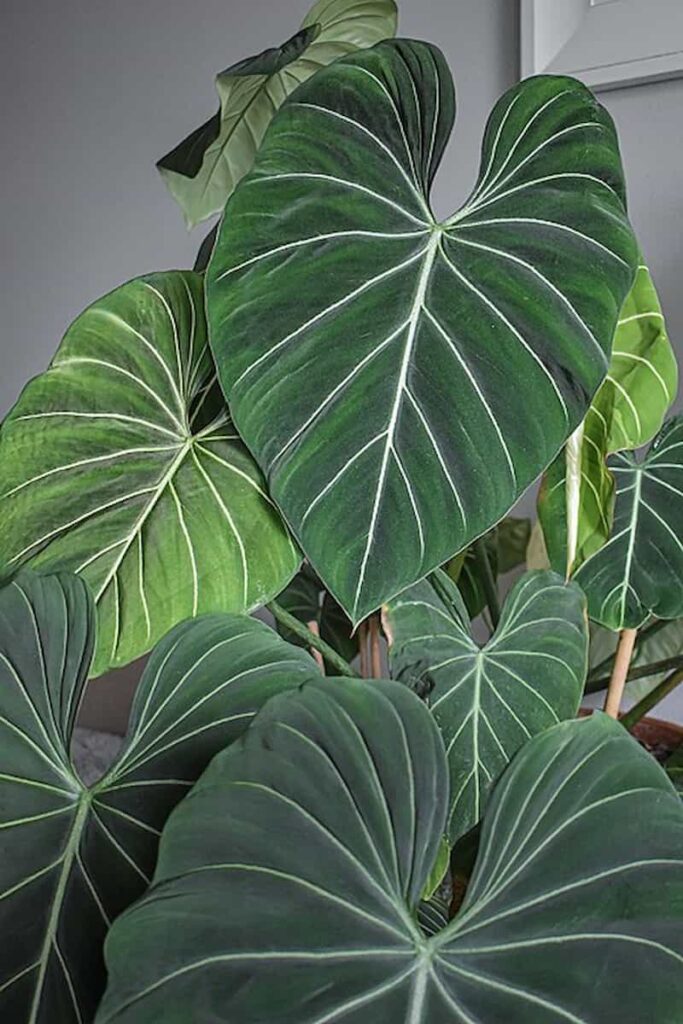
How big does a philodendron gloriosum get?
The Philodendron Gloriosum is a gentle giant, reaching a spread of up to 6 feet (2 meters) and a height of around 3 feet (1 meter) at maturity. Perhaps more impressive is the eventual size of its leaves, which, at total growth capacity, can reach 36 inches (90 centimeters) in length.
With its striking good looks and impressive stature, it’s no surprise that the Gloriosum is as popular as it is. Pictures on the internet can be deceiving, as this beauty grows to be breathtakingly large in ideal environments – although it will take a good couple of years.
Indeed, good things come to those who wait, and the Gloriosum is a famously slow grower. Only reaching maturity at a whopping 15 years, you can expect your philodendron to remain on the smaller side initially, with its leaves becoming larger over time.
That said, it has a clustered growth habit, making it a full, dense-looking plant perfect as an ornamental. Initially, you’ll experience inconsistent leaf sizing, but this will balance out as your plant grows older and more expansive.
Is philodendron gloriosum hard to grow?
The Philodendron Gloriosum is not hard to grow. It’s just not fast. If all its care requirements are met in terms of light, nutrients, humidity, and hydration, and it remains free of ailments, it’s pretty happy to plod along at its own pace.
Of course, some regular maintenance can be beneficial, like occasional fertilization and seasonal pruning. You may also need to repot your Gloriosum every few years to prevent it from becoming rootbound.
Is philodendron gloriosum rare?
Currently, the Philodendron Gloriosum is still considered a rare plant. This is primarily because of the law of supply and demand. Production of these plants is slow because seeds are scarce, and propagation takes time. Ultimately, suppliers cannot keep up with market requirements.
If you’re hoping to find a Gloriosum adorning the shelves of your local nursery, you may be out of luck. While this beauty is an investment worth making, you’ll need to do some digging (and splurge!) to get your hands on a Gloriosum.
Even though platforms like Instagram are making rare philodendrons all the more popular, the default for obtaining these specimens is through specialist suppliers or online merchants. Occasionally, plant-share forums make it possible to trade between collectors, but this is the exception rather than the rule.
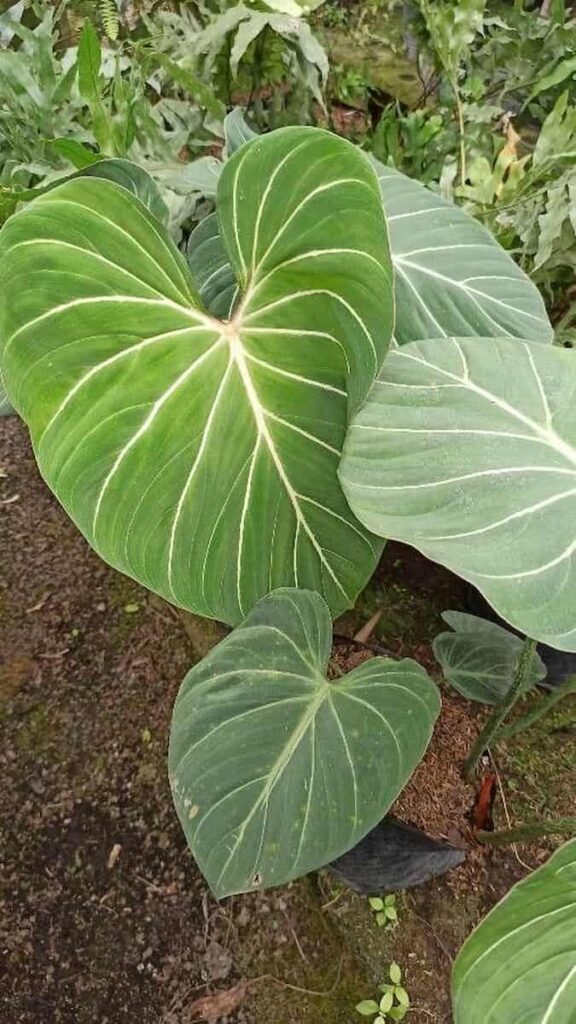
Are there different types of philodendron gloriosum?
There are several varieties of Philodendron Gloriosum which can be distinguished by their foliage shape and coloring. The most common is the Dark Form Gloriosum, and the rarest is the variegated variety.
Once you go Gloriosum, you never go back. And to keep your collection even more exciting, you’ll be thrilled to discover that there are several varieties of this stunning plant available which are each unique and breathtaking in their own way.
From dark leaves to rounded ones, let’s look at what different Gloriosum cultivars are out there.
1. Dark Form philodendron gloriosum
As its name suggests, the Philodendron Gloriosum ‘Dark Form’ has thick, dark green leaves with delicate, silvery veining and a signature red edging.
The lighter green veins prominent on the basic Gloriosum are less present in this variety, and the leaves themselves are slightly rounder, too.
2. Variegated philodendron gloriosum
The unicorn of the Gloriosum family is the variegated variety, which is very, very hard to come by. Variegated specimens look similar to the basic Gloriosum, except that areas of their leaves are dappled with yellow or cream.
They’re a little harder to maintain as they require some additional light and may start to revert if they don’t receive adequate sun.
3. Pink back philodendron gloriosum
This variety of Gloriosum is characterized by pink rather than white or light green veins, with a pale dusky pink underleaf. Beautifully feminine, this variety is a jungle queen with an unusual aesthetic. Its color grows more prominent as it matures.
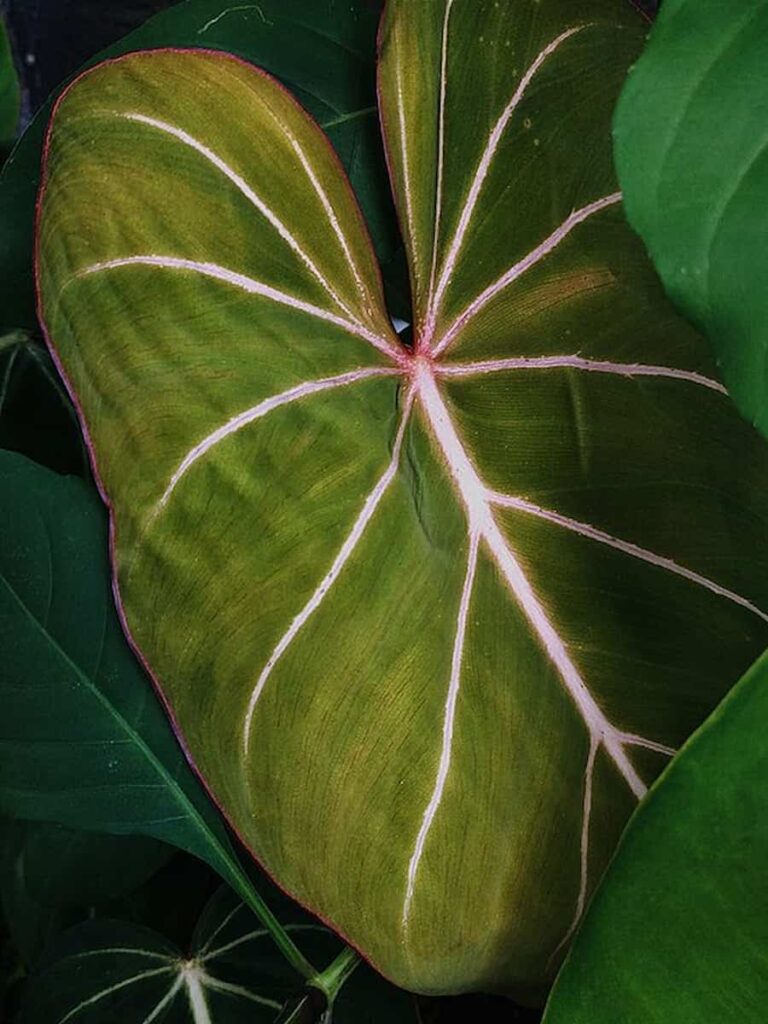
4. Round form philodendron gloriosum
At a young age, this variety of Philodendron Gloriosum can be hard to distinguish, but as it matures, you’ll notice a distinctly rounder leaf shape than usual.
Where the standard Gloriosum has a heart-shaped leaf with a prominent sharp tip, this variety is gentler and rounder in shape and devoid of a noticeable sharp top edge.
5. Philodendron gloriosum ‘zebra’
The Philodendron Gloriosum ‘Zebra’ is characterized by striking bright white leaf veins that starkly contrast with its dark green hues.
6. Philodendron gloriosum silver
The Philodendron Gloriosum Silver is a stunning plant, known for its velvety, heart-shaped leaves.
Its name comes from the fact that its foliage has light contrasting veins running through it which, if the light hits the plant at just the right angle, shimmer as if they were streams of silver.
Philodendron gloriosum vs philodendron glorious: what’s the difference?
The main difference between the Glorious and the Gloriosum is that the former is a climbing variety, whereas the latter is a terrestrial plant. The Philodendron Glorious also has smaller leaves which are lighter green in color than those of the Gloriosum.
The Philodendron Glorious is a hybrid of the Philodendron Melanochrysum and the Philodendron Gloriosum, and it shares the best aspects of both. It has bright white veins, a velvety texture, and distinctive heart-shaped leaves.
As mentioned, Glorious philodendrons have slightly narrower leaves than the Gloriosum, which they get from the Melanochrysum, as well as a lighter green coloring. Indeed, the edges of the Gloriosum tend to be pink or reddish, while the Glorious has a white border.
In terms of growth habit, the Glorious is a vining plant with a round petiole, in contrast to the crawling Gloriosum, which has a flat petiole and a more clustered shape.
It can be hard to tell these two philodendron types apart at a young age, but as they mature, their growth tendencies and petioles make their differences more prevalent.

Is philodendron gloriosum hardy?
The good news for collectors is that the Philodendron Gloriosum is a very hardy plant. It has easy care requirements and flourishes in various living conditions provided it has access to plenty of humidity. The Gloriosum is also disease-resistant, with its most significant threat being root rot.
I hate to tempt fate, but you’ll be hard-pressed to kill off a Gloriosum unless you’re very inconsistent with its care. The main issues you may experience in looking after this plant are generally related to either overwatering (root rot risk) or underwatering.
Fortunately, Gloriosum are great communicators, and you’ll quickly know if something has gone awry.
To diagnose ill health, start by looking for any signs of wilting or browning. Wilting can be related to a root issue, like fungi or bacteria, or may simply indicate dehydration. If neither of those seems to be the issue, check that your plant receives enough light and humidity.
Other signs of something wrong include slowed or leggy growth or burnt edges. These are usually light-related, most commonly a deficiency. Or conversely, sunburn from direct exposure.
For a little boost, you can treat your Philodendron Gloriosum to a half-dose of slow-release fertilizer, but this isn’t strictly necessary unless it’s really struggling to thrive. Should that be the case, consider repotting your plant to prevent it from becoming rootbound or replenishing its soil, which tires over time.
Should the philodendron gloriosum rhizome be above or below the soil?
As a crawling plant, the Philodendron Gloriosum has a horizontal rhizome from which it grows its stems and leaves. In its natural environment, the Gloriosum crawls along the forest floor, and for this reason, its rhizome should never be submerged but instead should rest only partially nested in soil.
Part of what makes the Gloriosum so interesting is that it’s a crawler rather than a creeper. Indeed, this means that it has a thick rootstock, or rhizome, which needs to be above ground for it to sprout new growth. Beneficially, the fact that its root has access to fresh air and light makes it even more resistant to root rot.
A shallow root system also makes the Gloriosum a prime candidate for alternative substrates like LECA.
